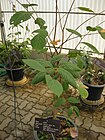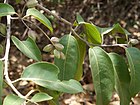Note: This is a project under development. The articles on this wiki are just being initiated and broadly incomplete. You can Help creating new pages.
Difference between revisions of "Terminalia chebula - Haritaki"
m (Prabhakar moved page Haritaki (Terminalia chebula) to Terminalia chebula - Haritaki) |
|||
| Line 1: | Line 1: | ||
[[File:Terminalia chebula - South China Botanical Garden 2013.11.02 11-07-25.jpg|thumb|right|''Haritaki'', ''Terminalia chebula'']] | [[File:Terminalia chebula - South China Botanical Garden 2013.11.02 11-07-25.jpg|thumb|right|''Haritaki'', ''Terminalia chebula'']] | ||
| + | '''Terminalia chebula''' is regarded as a universal panacea in Ayurveda and in the traditional Tibetan medicine. The fruit also provides material for tanning leather and dyeing wool,silk and cotton. | ||
| − | + | ==Uses== | |
| + | {{Uses|Wounds}}, {{Uses|Cuts}}, {{Uses|Snakebites}}, {{Uses|Curing liver disorders}}, {{Uses|Skin eruptions}}, {{Uses|Blotches}}, {{Uses|Pimples}}, {{Uses|Diarrhea}}, {{Uses|Sore throats}} | ||
| − | + | ==Parts Used== | |
| + | {{Parts Used|Dried Folaige}}, {{Parts Used|Whole herb}}. | ||
| − | + | ==Chemical Composition== | |
| + | Main chemical constitutes are chebulagic acid, chebulinic acid, corilagin, beta-sitosterol, gallic acid, ellagic acid, ethyl gallate, tannic acid, galloyl glucose & chebulaginic acid.<ref name="chemical composition"/> | ||
| − | ==Common | + | ==Common names== |
| + | {{Common names|kn=|ml=|sa=|ta=|te=|hi=|en=Agrimony}} | ||
| − | + | ==Properties== | |
| − | + | Reference: Dravya - Substance, Rasa - Taste, Guna - Qualities, Veerya - Potency, Vipaka - Post-digesion effect, Karma - Pharmacological activity, Prabhava - Therepeutics. | |
| − | + | ===Dravya=== | |
| − | == | + | ===Rasa=== |
| + | Tikta (Bitter), Kashaya (Astringent) | ||
| + | ===Guna=== | ||
| + | Laghu (Light), Ruksha (Dry), Tikshna (Sharp) | ||
| + | ===Veerya=== | ||
| + | Ushna (Hot) | ||
| + | ===Vipaka=== | ||
| + | Katu (Pungent) | ||
| + | ===Karma=== | ||
| + | Kapha, Vata | ||
| + | ===Prabhava=== | ||
| − | *[https:// | + | ==Habit== |
| + | {{Habit|Evergreen Tree}} | ||
| + | |||
| + | ==Identification== | ||
| + | ===Leaf=== | ||
| + | {{Leaf|Simple||The leaves are divided into 3-6 toothed leaflets, with smaller leaflets in between}}<ref name="Leaf"/> | ||
| + | |||
| + | ===Flower=== | ||
| + | {{Flower|Unisexual|2-4cm long|Yellow|5-20|Flowers are simple or branched axillary spikes. Flowering from March-May}} | ||
| + | |||
| + | ===Fruit=== | ||
| + | {{Fruit|Obovoid|7–10 mm|Fruiting April onwards|Oblong-ellipsoid drupe, faintly angled, glossy, glabrous|seed solitary}} | ||
| + | |||
| + | ===Other features=== | ||
| + | |||
| + | ==List of Ayurvedic medicine in which the herb is used== | ||
| + | * [[Vishatinduka Taila]] as ''root juice extract'' | ||
| + | |||
| + | ==Where to get the saplings== | ||
| + | ==Mode of Propagation== | ||
| + | {{Propagation|Seeds}}, {{Propagation|Cuttings}}. | ||
| + | |||
| + | ==How to plant/cultivate== | ||
| + | Succeeds in tropical and subtropical areas up to an elevation of 1,500 metres, exceptionally to 2,000 metres. It grows best in areas where the mean maximum and minimum annual temperatures are within the range 22 - 35°c, though it can tolerate<ref name="How to plant/cultivate"/> | ||
| + | |||
| + | ==Commonly seen growing in areas== | ||
| + | {{Commonly seen|Scattered in teak forest}}, {{Commonly seen|mixed deciduous forest}}. | ||
| + | |||
| + | ==Photo Gallery== | ||
| + | <gallery class="left" caption="" widths="140px" heights="140px"> | ||
| + | |||
| + | Gardenology.org-IMG 8014 qsbg11mar.jpg | ||
| + | |||
| + | Harado (Prakrit- हरडओ) (3309176804).jpg | ||
| + | |||
| + | |||
| + | Hardi (Gujatati- હરડી) (3308353833).jpg | ||
| + | |||
| + | |||
| + | Hardi (Konkani- हरडी) (3641857568).jpg | ||
| + | |||
| + | |||
| + | Haritaki (Bengali- হরীতকী) (3496496138).jpg | ||
| + | |||
| + | </gallery> | ||
| + | |||
| + | ==References== | ||
| + | |||
| + | <references> | ||
| + | <ref name="chemical composition">[http://www.motherherbs.com/terminalia-chebula-extract.html "chemical constituents"]</ref> | ||
| + | |||
| + | <ref name="Leaf">[https://indiabiodiversity.org/species/show/31838 "Morphology"]</ref> | ||
| + | |||
| + | <ref name="How to plant/cultivate">[http://tropical.theferns.info/viewtropical.php?id=Terminalia+chebula "Cultivation Details"]</ref> | ||
| + | </references> | ||
| + | |||
| + | ==External Links== | ||
| + | * [https://www.ncbi.nlm.nih.gov/pmc/articles/PMC3631759/ The development of Terminalia chebula Retz. (Combretaceae) in clinical research] | ||
| + | * [https://haritaki.org/cultivation-of-haritaki-myrobalans-terminalia-chebula/ Learn How to grow Haritaki] | ||
| + | * [http://www.pitchandikulam-herbarium.org/contents/description-leaf.php?id=149 Terminalia chebula on pitchandikulam-herbarium.org] | ||
| + | * [http://www.planetayurveda.com/library/haritaki-terminalia-chebula Terminalia chebula on planet ayurveda] | ||
[[Category:Herbs]] | [[Category:Herbs]] | ||
Revision as of 12:25, 11 June 2018
Terminalia chebula is regarded as a universal panacea in Ayurveda and in the traditional Tibetan medicine. The fruit also provides material for tanning leather and dyeing wool,silk and cotton.
Contents
- 1 Uses
- 2 Parts Used
- 3 Chemical Composition
- 4 Common names
- 5 Properties
- 6 Habit
- 7 Identification
- 8 List of Ayurvedic medicine in which the herb is used
- 9 Where to get the saplings
- 10 Mode of Propagation
- 11 How to plant/cultivate
- 12 Commonly seen growing in areas
- 13 Photo Gallery
- 14 References
- 15 External Links
Uses
Wounds, Cuts, Snakebites, Curing liver disorders, Skin eruptions, Blotches, Pimples, Diarrhea, Sore throats
Parts Used
Chemical Composition
Main chemical constitutes are chebulagic acid, chebulinic acid, corilagin, beta-sitosterol, gallic acid, ellagic acid, ethyl gallate, tannic acid, galloyl glucose & chebulaginic acid.[1]
Common names
| Language | Common name |
|---|---|
| Kannada | |
| Hindi | |
| Malayalam | |
| Tamil | |
| Telugu | |
| Marathi | NA |
| Gujarathi | NA |
| Punjabi | NA |
| Kashmiri | NA |
| Sanskrit | |
| English | Agrimony |
Properties
Reference: Dravya - Substance, Rasa - Taste, Guna - Qualities, Veerya - Potency, Vipaka - Post-digesion effect, Karma - Pharmacological activity, Prabhava - Therepeutics.
Dravya
Rasa
Tikta (Bitter), Kashaya (Astringent)
Guna
Laghu (Light), Ruksha (Dry), Tikshna (Sharp)
Veerya
Ushna (Hot)
Vipaka
Katu (Pungent)
Karma
Kapha, Vata
Prabhava
Habit
Identification
Leaf
| Kind | Shape | Feature |
|---|---|---|
| Simple | The leaves are divided into 3-6 toothed leaflets, with smaller leaflets in between |
Flower
| Type | Size | Color and composition | Stamen | More information |
|---|---|---|---|---|
| Unisexual | 2-4cm long | Yellow | 5-20 | Flowers are simple or branched axillary spikes. Flowering from March-May |
Fruit
| Type | Size | Mass | Appearance | Seeds | More information |
|---|---|---|---|---|---|
| Obovoid | 7–10 mm | Fruiting April onwards | Oblong-ellipsoid drupe, faintly angled, glossy, glabrous | seed solitary | {{{6}}} |
Other features
List of Ayurvedic medicine in which the herb is used
- Vishatinduka Taila as root juice extract
Where to get the saplings
Mode of Propagation
How to plant/cultivate
Succeeds in tropical and subtropical areas up to an elevation of 1,500 metres, exceptionally to 2,000 metres. It grows best in areas where the mean maximum and minimum annual temperatures are within the range 22 - 35°c, though it can tolerate[3]
Commonly seen growing in areas
Scattered in teak forest, mixed deciduous forest.
Photo Gallery
References
External Links
- Ayurvedic Herbs known to be helpful to treat Wounds
- Ayurvedic Herbs known to be helpful to treat Cuts
- Ayurvedic Herbs known to be helpful to treat Snakebites
- Ayurvedic Herbs known to be helpful to treat Curing liver disorders
- Ayurvedic Herbs known to be helpful to treat Skin eruptions
- Ayurvedic Herbs known to be helpful to treat Blotches
- Ayurvedic Herbs known to be helpful to treat Pimples
- Ayurvedic Herbs known to be helpful to treat Diarrhea
- Ayurvedic Herbs known to be helpful to treat Sore throats
- Herbs with Dried Folaige used in medicine
- Herbs with Whole herb used in medicine
- Herbs with common name in English
- Habit - Evergreen Tree
- Index of Plants which can be propagated by Seeds
- Index of Plants which can be propagated by Cuttings
- Herbs that are commonly seen in the region of Scattered in teak forest
- Herbs that are commonly seen in the region of mixed deciduous forest
- Herbs





